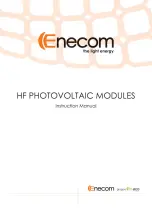
Page
5
SunFrame
Unirac Code-Compliant Installation Manual
R
1411 Broadway Boulevard NE
Albuquerque NM 87102-1545 USA
Step 4: Determine
Net Design Wind Pressure,
p
net30
(psf):
Using the
Effective Wind Area
(Step 2)
,
Roof Zone Location
(Step 3), and
Basic Wind Speed
(Step 1)
, look up the
appropriate
Net Design Wind Pressure
in
Table 2, page 6
. Use
the
Effective Wind Area
value in the table which is smaller than
the value calculated in
Step 2
. If the installation is located on a
roof overhang, use
Table 3, page 7
.
Both downforce and uplift pressures must be considered
in overall design . Refer to Section II, Step 1 for applying
downforce and uplift pressures . Positive values are acting
toward the surface . Negative values are acting away from the
surface .
Figure 2. Enclosed buildings, wall and roofs
Flat Roof
Hip Roof (7˚ <
θ
≤ 27°)
Gable Roof (
θ
≤ 7°)
Gable Roof (7˚ <
θ
≤ 45°)
Interior Zones
Roofs - Zone 1/Walls - Zone 4
End Zones
Roofs - Zone 2/Walls - Zone 5
Corner Zones
Roofs - Zone 3
Step 3: Determine
Roof Zone (continued):
Using
Roof Zone Setback Length
, a, determine the roof zone
locations according to your roof type, gable, hip or monoslope .
Determine in which roof zone your pv system is located, Zone
1, 2, or 3 according to
Figure 2
.
Source: ASCE/SEI 7-05, Minimum Design Loads for Buildings and Other Structures, Chapter 6, p. 41.
h
a
a
a
a
h
a
a
a
a
a TYP
h
a
a
a
a
h
a
a
a
a






































